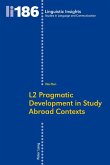This collection of essays on Spanish pragmatics can be understood in its broadest sense in Iacob L. Mey's words as «the study of the conditions of human language use in a societal context.» The essays, which can be read independently from one another, revolve around three key areas within the Anglo-American school of pragmatics: speech acts, conversation, and politeness as sociocultural manifestations of communication.
The first part of the book emphasizes the study of politeness in different Spanish-speaking communities, paying special attention to the realization of polite speech acts and their cross-cultural and cross-linguistic implications, as well as the face-work that interlocutors conduct in casual conversations and other communicative settings. The second part expands the topic of politeness strategies to the study of new contexts (such as echo questions and conversational repairs) and addresses other language phenomena that can be best explored from a pragmalinguistic perspective, such as evidentiality, mitigation, contrastive emphasis, and topicality and discourse salience.
The examples (with the exception of a few literary quotes) proceed from naturally occurring data or were collected through questionnaires, and represent a wide range of colloquial «Spanishes,» from Peninsular to Latin American, from monolingual to bilingual, and from native to heritage to second language learners' varieties.
The empirical nature of Aspects of Spanish Pragmatics will appeal to a wide range of readers interested in the use of Spanish for real-life communicative interactions, as well as in the topic of intercultural communication and the teaching of authentic language to students of Spanish in the United States.
The first part of the book emphasizes the study of politeness in different Spanish-speaking communities, paying special attention to the realization of polite speech acts and their cross-cultural and cross-linguistic implications, as well as the face-work that interlocutors conduct in casual conversations and other communicative settings. The second part expands the topic of politeness strategies to the study of new contexts (such as echo questions and conversational repairs) and addresses other language phenomena that can be best explored from a pragmalinguistic perspective, such as evidentiality, mitigation, contrastive emphasis, and topicality and discourse salience.
The examples (with the exception of a few literary quotes) proceed from naturally occurring data or were collected through questionnaires, and represent a wide range of colloquial «Spanishes,» from Peninsular to Latin American, from monolingual to bilingual, and from native to heritage to second language learners' varieties.
The empirical nature of Aspects of Spanish Pragmatics will appeal to a wide range of readers interested in the use of Spanish for real-life communicative interactions, as well as in the topic of intercultural communication and the teaching of authentic language to students of Spanish in the United States.








